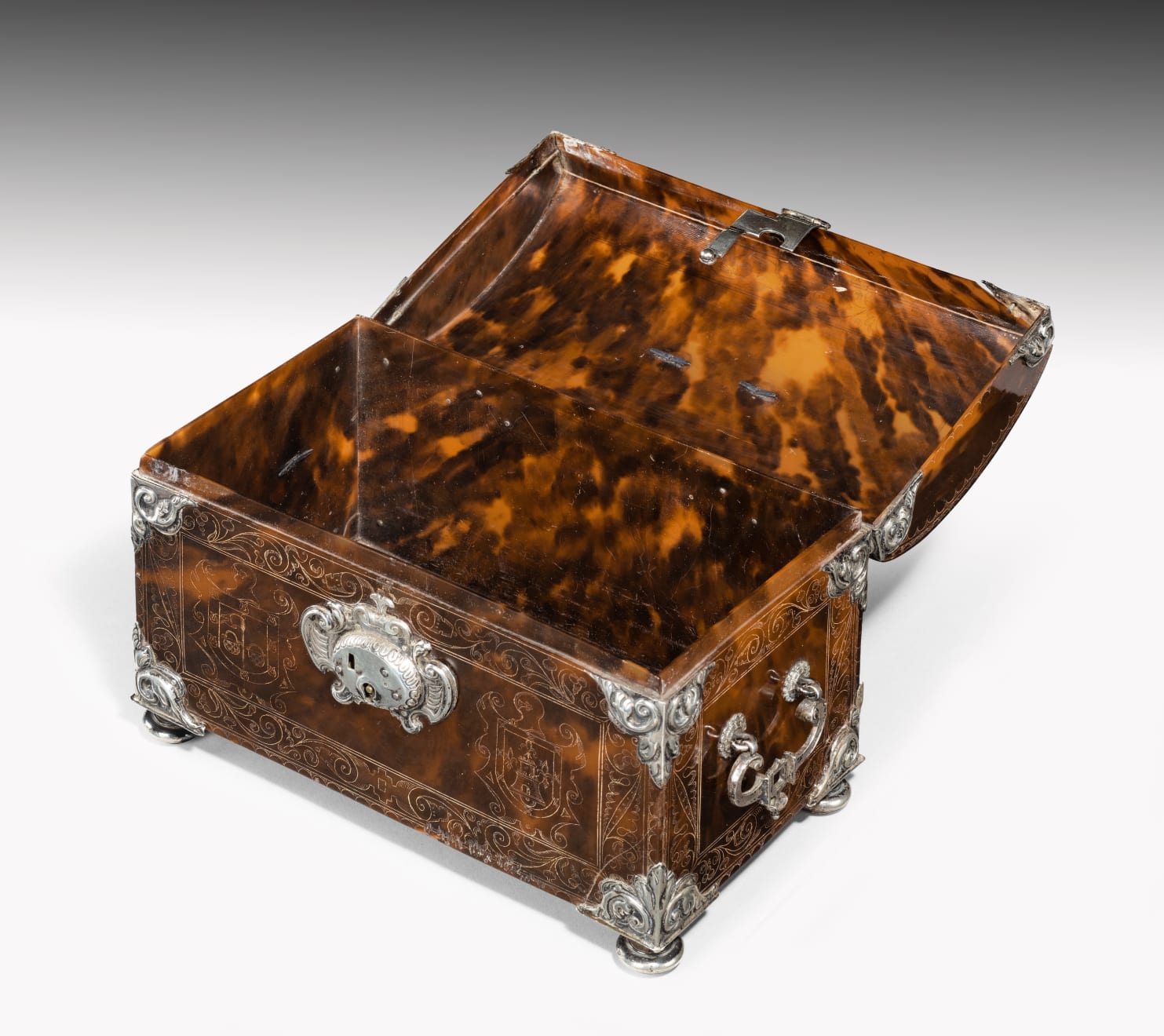17th Century Engraved Tortoiseshell Silver Mounted Casket
PROBABLY MEXICAN, circa 1615
Inscribed: ‘De Doña Juliana / Castilleja y Altamirano’.
15.5 x 22 x 12 cm
Further images
Provenance
Commissioned by Juliana Castilleja y Altamirano (1565-1630) and probably given to her niece Juliana Molina y Altamirano Toro, in 1615, on the occasion of her wedding.
Latterly in the Private Collection of Sylvain Durand (1923-2018), at Château de Renay.
An oblong casket made of tortoiseshell, with an arched lid, engraved ornament and with silver mounts. Engraved with borders of scrolling foliage and coats of arms. The mounts consist of a lock and a hasp; hinges; a loop handle on the lid; two carrying handles, one on each end; angle plates; and four feet.
The partially erased dedication on the back of the casket suggests that it was given as a gift by Dona Juliana Castilleja y Altamirano; perhaps as a wedding gift on the occasion of the marriage of her niece and goddaughter, Juliana Molina y Altamirano Toro. The bride was the daughter of her younger sister and Cosme de Molina y Herrera, governor of Valdivia (Chile), son of Hernando de Molina and Elvira de Herrera with Luis Núñez de Vergara. The donor - Juliana Castilleja y Altamirano - was born in Altamirano y Toro, daughter of Julián Gutiérrez de Altamirano and of Mariana Toro Omepezoa and wife of Pedro Páez de Castilleja Valenzuela.
In 1521 Julian Gutiérrez de Altamirano (1521-1592), the father of the donor of this casket, was born in Huete, in the province of Cuenca, Spain. In 1550, he moved to Chile and founded the city of Concepción. In 1552 he was appointed Governor of Valdivia and ruler of Los Confines in 1554. In February 1558, by order of Governor Hurtado de Mendoza, he directed the expedition of Reloncaví with Alonso de Ercilla y Zúñiga. He was Lieutenant general of the kingdom. Julian Gutiérrez de Altamirano died whilst defending Valdivia in 1599 in Chile.
The Herrera coat of arms shows two gold (or) and black (sable) chequered cauldrons set on a red (gules) background, surrounded by a gold (or) bordure decorated with eight equally spaced blue (azure) horseshoes. The Molina coat of arms shows a centrally placed silver (argent) tower above a windmill’s half-wheel surrounded by three gold (or) fleur-de-lis set on a blue (azure) background, with a red (gules) bordure with eight gold (or) crosses. Interestingly the fleur-de-lis on the silver lock decoration of the casket uses one of the main heraldic elements of the Molina coat of arms.
Toribio de Benavente (1482-1568), also known as Motolinía, was one of twelve Franciscan missionaries who arrived in ‘New Spain’ in Mexico in 1524, entrusted with a mission to convert the native peoples to Christianity. In his book ‘Historia de los indios de la Nueva España’ (‘History of the Indians of New Spain’), which he finished in 1541, he writes about the Native Americans who he was trying to convert – the people, their customs, the landscape, and the fauna and flora. Motolinía criticised the Spanish settlers’ mistreatment of the indigenous people. His writings celebrate the ingenuity of the native craftsmen: ‘the Indians have reached a high degree of perfection in the mechanical trades, both those which they originally knew and those which they learned for the first time from the Spaniards’. He claimed that they emulated and then surpassed the skills of Spaniards, learning about European styles and incorporating them into their own work. He states: ‘they never make anything without changing the style, seeking to create new models’. The use of tortoiseshell with sgraffito was a technique which was used in the Spanish colonies for luxury items such as caskets such as this, sewing cabinets and mirrors.
The engraved tortoiseshell on this casket suggests a Mesoamerican origin, probably Mexico. A similar domed casket with engraved tortoiseshell is part of the Hans Schell Collection in Graz. It is believed that the technique for engraving tortoiseshell was introduced to the Americas by Missionaries travelling from India. Similar caskets and other objects were exported by Spanish, Dutch and Portuguese trading companies, and were usually intended for selling on the European market.
Francisco Marcos illustrates a collection of 17th century tortoiseshell caskets with silver fittings in the exhibition catalogue ‘Las Artes del Nuevo Mundo’ (Coll & Cortés and Francisco Marcos, Madrid, 2011), on page 36, figures 20-24. He also illustrates a slightly later casket with claw feet and golden corners, dated 1700, on page 37, figure 25.












